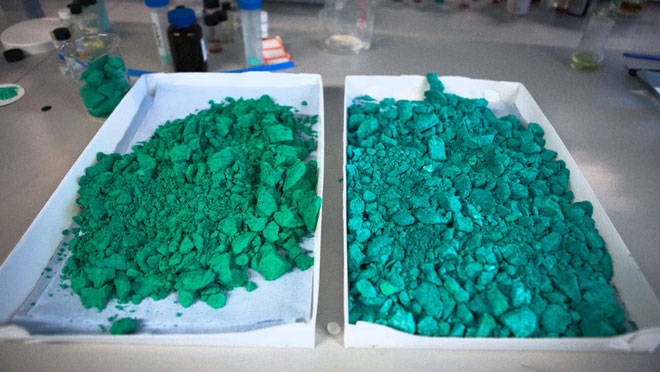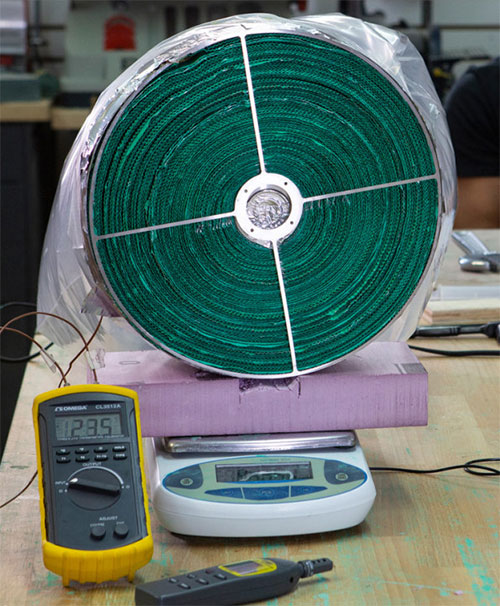By attaching to a dehumidifier, nanomaterials can create water from 'nothingness'.
Climate change has brought about dreadful consequences, and cities have suffered more severe drought than before, which has forced local governments to cut people's water for weeks. Fortunately, there is a new material that can get clean water right from the air, a miraculous material that can save mankind in thirst.
This sponge-like nanomaterial is the product of Limerick University in Ireland, combined with a research fund called Molecule. The team of scientists designed it to combine with existing dehumidifiers on the market, it can both help HVAC systems (Heat, Ventilation, Air Conditioning - Heat, Ventilation, Air Conditioning). save energy, and can become a living water source.

This new material has a sponge-like structure.
The team has been able to imagine a bright future, where this special material can appear in hot dry regions around the world, from Sydney, Australia to Chennai, India.
' Northern China and the whole of India are areas that are constantly under water shortage, and the situation is getting worse ,' said Michael Zaworotko, a professor at Limerick University. ' Before we worry about climate change, the situation is urgent when one-third of the world's population lives in areas of serious water shortage. One third of the population will face water shortages within the next 10 years . '
Science tells us that only 1/1000 of the world's water is stored in the atmosphere, but Zaworotko also added that ' but they are everywhere, and are a source of everlasting renewable water. '.
' If you take water from the air, it will be recycled water from the ocean .' Retrieving water from the air is an excellent way to combat water shortages, even if local communities are facing groundwater pollution or any water shortage.

This material will help get water from the air efficiently.
This is not the first time mankind has found water available in the air. Startup Zero Mass Water also had a similar project: they designed roof-mounted systems (also made of nanomaterials) to absorb water, then used solar energy to bring water down to households. This system was used at a children's hospital located in Jamaica.
Molecule has the same idea, but they can improve the technology available. The organization brought the idea to Professor Michael Zaworotko and received positive affirmations.
'The material that absorbs water from the air in this technology contains all three essential elements ,' says Professor Zaworotko. ' It works in low humidity conditions, meaning that desert activities are just as effective as those with lots of moisture. The recycling does not take much effort and consume energy. And the third - the most important factor, which makes many similar materials impossible - is the rate at which water is absorbed and produced . '
This miraculous material, called Regeneration Optimized Sorbent 37 (ROS-037) , is super tiny, nano-meter holes, just enough to separate water from the air. For example, inside a dehumidifier located on the top of a tall building, you can replace the dehumidifying material available in the machine with ROS-037. The attached system will collect water from the air during the time the dehumidifier operates.
In the test, with a sample machine and 1kg of ROS-037 material, the research team produced about 1 liter of water per hour in dry and cold conditions. This speed is enough for a regular dehumidifier to produce enough water for a day. If the ROS-037 material is installed in a large HVAC system, it will produce thousands of liters of water every hour.

This amazing material is called Regeneration Optimized Sorbent 37.
ROS-037 will also help the HVAC system save energy. Large buildings in the US use up to 40% of the electricity produced, and HVAC systems use up to half of the energy a building needs. ' If we take into account HVAC systems in office buildings, dehumidifiers are the most energy-efficient systems ,' says Kurt Francis, chief technology officer at Molecule. ' And if we can reduce the amount of energy that goes into these machines, we can stop carbon before they are released into the environment .'
At the moment, Molecule is trying to commercialize new materials. A major shopping center in Southern California has registered to be the first to test and install new materials into its HVAC system. Molecule will also develop a compact machine, applicable to ROS-037 and powered by solar, wind or battery power, to be carried around the world.

ROS-037 helps HVAC system save energy.
' The beauty of this system is that it is extremely simple ,' said Bjorn Simundson, CEO of Molecule. ' Thanks to this material, you can convert a commercially available dehumidifier to create water with only electricity in your home, and it won't consume too much electricity either. A system like this that can run on solar, wind and have a backup battery system will be able to generate water when placed anywhere. '
- Detecting new carbon nanomaterials
- For the first time, a nanomaterial has been created that is both liquid and solid
- Successfully combining super new nanomaterials
- Make a drink from the fog
- Nanotechnology and applications
- 6 technologies used to create clean drinking water: taken from air, filtered seawater ...
- Video: How to create fire from lemon extremely unique
- Create hydrogen fuel from sunlight and waste water
- Successfully invented the water-generating machine from the air
- Using nanotechnology to create microchips for cancer detection
- Humans can produce hydrogen and oxygen, so why can't we produce water?
- Create fresh water with solar energy
 The US company is about to build a supersonic passenger plane of 6,000km / h
The US company is about to build a supersonic passenger plane of 6,000km / h Japan develops avatar robot as in fiction film
Japan develops avatar robot as in fiction film Australia tested the world's first mango picking robot
Australia tested the world's first mango picking robot America develops technology to separate water from animal waste
America develops technology to separate water from animal waste